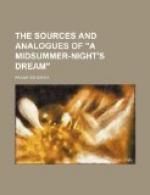The complete Chaucerian form of the story of Palamon and Arcite is dramatised in The Two Noble Kinsmen, a play to which Shakespeare undoubtedly[15] contributed. The changes made by the authors—Fletcher and Massinger or Shakespeare, or all three—are little more than such limitations as are demanded by dramatic form; for instance, the Kinsmen, when discovered fighting, are dismissed for a month to find three knights, instead of being given a year to find one hundred. Chaucer’s hint, that Palamon was assisted to escape from prison by a friend, is developed by the dramatists to make the sub-plot of the gaoler’s daughter. The character-drawing is far more subtle than the poet’s; Chaucer leaves the reader’s sympathies equally divided, despite the fact that he says plainly that Arcite was in the wrong, because he violated the compact of the two kinsmen to assist each other in love.
We must now consider what justification there is for believing that the main plot of A Midsummer-Night’s Dream was suggested by The Knightes Tale. Firstly, as has already been pointed out, the nuptials of Theseus form the beginning of both play and poem; though in the poem the actual ceremony has been performed, and it is his triumphant return to the city of Athens that is interrupted by the widows’ appeal for justice; and in the play the action passes in the three or four days before the marriage. Secondly, the wedding-day is the first of May, and there are two references to that “observance of May"[16] which is given by Chaucer as the reason both for Emilia’s walking in the garden and for Arcite’s seeking of the grove where Palamon lay hid.[17] Thirdly, it can hardly be doubted that Shakespeare took the name of Philostrate from Chaucer; Egeus he would find also in North’s Plutarch as the name of the father of Theseus; and it is possible that Chaucer’s names for the champions, Ligurge and Emetreus, may have suggested Lysander and Demetrius. Finally, there are two or three minor indications; Lysander and Demetrius fight, or attempt to fight, for Helena, in the “wood near Athens,” just as Palamon and Arcite fight for Emilia in the grove[18]; Theseus is a keen huntsman both in the poem and in the play[19]; and he refers[20] to his conquest of Thebes, which, as we have seen, is described in The Knightes Tale.
Apart from these details, I do not think Shakespeare is indebted to Chaucer. It is conceivable that the story of Palamon and Arcite affected, but did not supply, the plot of the four lovers in A Midsummer-Night’s Dream; but Shakespeare has added a second woman. This completion of the antithesis is characteristic of his early work; with a happy ending in view, the characters must fall into pairs, whereas with Palamon, Arcite, and Emilia, one of the men must be removed. There is nothing to prevent the supposition that Shakespeare was acquainted from boyhood with Chaucer’s story—either in Chaucerian form or possibly in the shape of a chap-book—and that he constructed a first draft of The Two Noble Kinsmen quite early in his career as a playwright, subsequently laying it aside as unsatisfactory, and, in his declining years, collaborating with another or others to produce the play on that theme.




